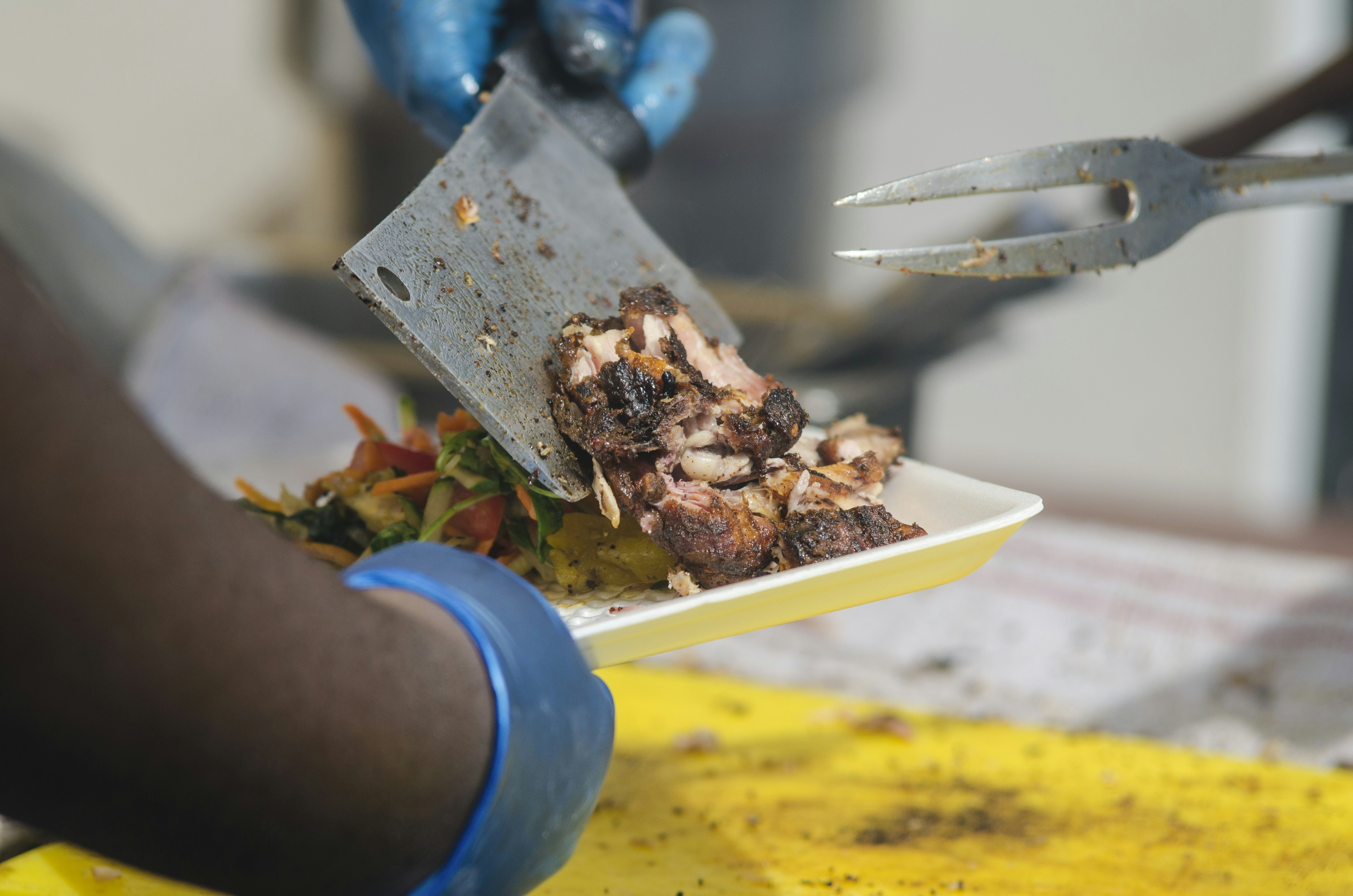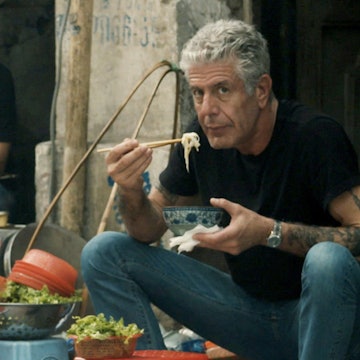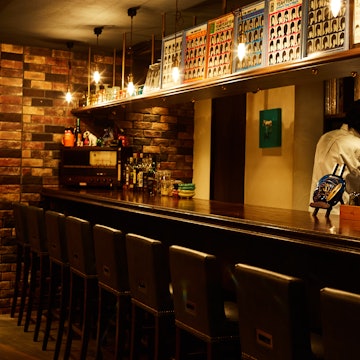

The smoky, spicy flavors of jerk chicken are a key part of Jamaican culture. petalouda/Shutterstock
The crackle of the grill, the rich scent of pimento-wood smoke, the bold spice of the marinade: all Jamaicans know these sensory pleasures well. Jerk chicken is as much a part of our island life as the sea breeze.
Jerk chicken is more than just a dish. It’s a cultural emblem, a legacy handed down from the African Maroons who perfected jerk cooking. Today, the dish represents our creativity, our uniqueness and that distinctive zest Jamaicans are known for around the world.
As for almost any Jamaican, jerk chicken is my go-to when I want a quick meal. It’s what I crave when I leave a party or an event at 2am, famished. And let’s not forget the COVID-19 times: when every restaurant was closed, the jerk men were still out there, grilling away with their pans (and their masks). For me, jerk chicken is my Ol’ Reliable – that dish that’s always available and always filling.
Here’s everything you need to know about this iconic dish, and where to find the best jerk chicken across Jamaica.

The history of jerk chicken in Jamaica
Jerk cooking has its origins in the practices of Jamaica’s Indigenous Taíno and Arawak peoples, who likely developed the earliest methods of “jerking” meat. The Taínos smoked and slow-cooked meat using a raised wooden framework, a method they called “barabicu” – one that later influenced barbecue cooking across the Americas and the world.
During the British invasion of 1655, some enslaved Africans escaped into Jamaica’s dense forests and mountainous regions, particularly the rugged Cockpit Country and the Blue Mountains. There, they joined with the dwindling Taíno population to form Maroon communities – and also blended their cooking techniques.
The Maroons hunted wild hogs, then seasoned the meat with native ingredients like allspice and Scotch bonnet peppers, before slow-cooking it over indigenous pimento wood. Often done in smokeless underground pits, this method or preparation was as much about flavor as survival, as it helped avoid detection by colonial forces. This was the beginning of the style we now know as jerk.
By the 18th century, jerk had become a hallmark of Maroon cuisine, with its signature fiery spice blend and deep, smoky aroma. The Maroons continued to perfect the method, applying it to other meats such as chicken and fish, and passing it down through generations.
Over time, jerk seasoning evolved to include such other ingredients as cloves, cinnamon, scallions, nutmeg, garlic, brown sugar and ginger. Jerk sauce followed suit, incorporating liquids like soy sauce and vinegar for a tangy, flavorful kick. Yet even as the ingredients have evolved, the core combination of allspice and Scotch bonnet peppers remains central to jerk’s bold flavor.
Today, jerk chicken is commonly made using jerk pans and grills for convenience. Yet the essence of jerk – that smoky, spicy tang provided delivered by the pimento wood – remains unchanged.

How to order jerk chicken in Jamaica
Beyond chicken, pork, fish, shrimp, lamb, rabbit and even tofu can be “jerked.”
Jerk meat is typically sold by the pound. A single serving is usually about a quarter pound and comes with a side, while a half pound works well to share with two people. For larger groups, plan on a pound or more.
At restaurants, you’ll need to purchase sides separately; common options include white bread, bammy (a deep-fried flatbread made from cassava), “festival” (a sweet fried dough), rice and peas, fried or roasted breadfruit, roasted sweet potato, fries, sweet corn, fried plantains, steamed vegetables, or coleslaw. Roadside jerk shacks often throw in one free side, usually a slice of bread or a festival (usually the only options at simpler joints).
It’s common for Jamaican food spots to serve jerk chicken in specific parts, typically a breast-and-wing or leg-and-thigh combo. While some places may let you mix it up (say, by pairing a breast with a leg), the combinations above are the usual standard. To get exactly what you want, be sure to specify your preferred part of the chicken when placing your order.
The sauce is a crucial part of the jerk experience. At roadside stands or shacks, the sauce is typically added directly to the meat; you can specify how much you want, or if you’d like extras like ketchup or pepper sauce. Restaurants tend to serve the sauce on the side, allowing you to control how much you add.
Local tip: A single serving of jerk chicken is one of the most inexpensive meals you’ll find in Jamaica. If an establishment is charging more than J$1200 or (US$7.60) for a quarter pound, it’s too much.
How to eat jerk chicken in Jamaica
Hearty and satisfying, jerk chicken is best enjoyed with your hands; utensils are not necessary (except for sides like rice and peas or coleslaw that might require a fork). Roadside vendors and small restaurants usually serve it wrapped in foil, while bigger establishments might plate it or pack it in a box. But even when a fork is offered, true aficionados know the real joy lies in tearing into the tender, flavorful meat with your fingers. Finger-licking is not just encouraged – it’s practically mandatory.
The best places to get jerk chicken in Jamaica

PeppaThyme
Vibes: With four large-screen TVs in its thatched-roof bar area, PeppaThyme is a favorite hangout spot for many Kingstonians. The restaurant’s open-air design – complete with wooden tables, benches and thatched roofing – gives it a breezy, rustic charm. Diners love PeppaThyme not only for its flavorful jerk chicken but also for its artisan jerk chicken and pork sausages. Because of its location in the Constant Spring area, this spot draws more of a “uptown Kingston” crowd (middle- and upper-class residents).
Cost: Jerk chicken starts at J$1100 ($7) per quarter pound.
How to get it: Reservations aren’t necessary. It’s usually laid-back during the week, with more visitors on a weekend. Lots of locals pick up food to go here.
Scotchies
Vibes: Relaxed and rustic, Scotchies has earned a reputation as one of the premier jerk spots in all of Jamaica. It’s the only jerk restaurant with multiple locations – Coral Gardens, Main Street Rose Hall and Fairview in Montego Bay; Drax Hall near Ocho Rios; and Falmouth Pier in Trelawny. The locations’ proximity to major hotels and tourist hubs makes them a favorite of visitors – and locals also swear by the place. Under thatched-roof seating areas, guests sip cold Red Stripe beers while watching chefs expertly cook over traditional pimento wood. Scotchies even bottles its signature hot sauce, available for purchase at all locations.
Cost: Jerk chicken starts at J$950 (US$6) per quarter pound.
How to get it: No reservations are necessary. For a laid-back vibe, visit during the week when it’s not too crowded. On weekends and public holidays, expect lines of tourists.

Sweetwood Jerk Joint
Vibes: Tucked in the heart of the bustling New Kingston business district, Sweetwood is a go-to for locals in the area seeking affordable lunches or convenient takeout. It’s also within walking distance of Emancipation Park, where many people go to relax. The vibe is straightforward and unpretentious: you place your order and pay at a simple zinc-and-wood stand, then take a seat in a plastic chair at a wooden table in the open-air seating area. While the jerk chicken is solid, Sweetwood is best known for its fall-off-the-bone jerk pork – tender, juicy and bursting with spicy flavor.
Cost: Jerk chicken starts at J$1000 (US$6.35) per quarter pound.
How to get it: Sweetwood is practically empty most days. You may see a short line during lunchtime (noon to 3pm) when locals stop by for their midday meal. Friday afternoons are busy, as Kingstonians grab jerk chicken or pork to take home for dinner for the weekend.

Ocho Rios Jerk Centre
Vibes: Situated in the heart of the town, Ocho Rios Jerk Centre is a magnet for visitors, thanks to its prime location just a three-minute drive from the cruise terminal. The menu is extensive and varied here, offering jerk chicken, pork, wraps, burgers, shrimp kebabs, and a massive jerk platter featuring chicken, pork and sausage.
Cost: A hearty plate of jerk chicken starts at J$950 (or around $6) per quarter pound.
How to get it: No reservations are required – but plan strategically. This spot gets packed every day after noon., especially on weekends. Arrive between noon and 4pm, and you might face at a 30-minute wait (at least) for your food.

Ultimate Jerk Centre
Vibes: Located near Discovery Bay, Ultimate Jerk Centre is a popular rest stop along Jamaica’s north coast. While Discovery Bay itself isn’t a bustling tourist hub, it sits conveniently between the island’s major destinations of Ocho Rios and Montego Bay. On any given day, locals stop by for a quick lunch, and you’ll occasionally spot school groups or buses filled with tourists fresh from exploring the Green Grotto Caves, just across the street. This spot stands out for its relaxed vibe and unique offerings, including the rare treat of jerk rabbit.
Cost: Jerk chicken starts at J$900 (US$5.70) per quarter pound.
How to get it: No reservations are needed – just stop by whenever you’re traveling along the northern coast. Expect a reliable and delicious pit stop.

Murray’s Fish and Jerk Hut
Vibes: As the top rest stop on Jamaica’s south coast, Murray’s is tucked away in Toll Gate, Clarendon, far from the usual tourist crowds. While you won’t find many outsiders here, locals frequent the spot regularly for its excellent variety of jerk dishes, including chicken, pork, fish, sausage and even rabbit. For a heartier meal, you can enjoy your jerk dish with a side of rice and peas. Murray’s also sells its own jerk sauce and seasoning.
Cost: Jerk chicken starts at J$900 (US$5.70) per quarter pound.
How to get it: Murray’s is the perfect spot to pull over, relax and refuel – and an ideal stop during road trips. On weekends and public holidays, the place can get crowded, so if you prefer a quieter experience, try stopping by during the week.

How to get jerk on the road in Jamaica
For jerk-chicken takeout, roadside stands are the go-to option. These establishments are often run by skilled men standing over drum-pan grills – repurposed oil drums filled with hot coals and topped with a grill rack. The smoky aroma of pimento wood and spices infuses the air as they expertly cook chicken, pork or fish to perfection.
While these stands are relatively quiet during the week, weekends bring a bustling crowd of Jamaicans who line up to grab their jerk to take home. The meat always comes wrapped in foil. From Friday to Sunday, these grill masters often work late into the night, catering to hungry partygoers through the early hours of the morning, usually until 2am or 3am.
Local tip: If you’re driving around, you won’t usually find jerk stands set up early in the day. Check after midday, when the sun abates.
How to take jerk chicken home with you from Jamaica
If you want to take a touch of jerk with you when you leave Jamaica, consider purchasing bottled jerk marinades, sauces or seasonings from local brands like Walkerswood, Spur Tree Spices, Eaton’s Jamaica or Grace Foods, which are found in most Jamaican grocery stores. These TSA-friendly options are an easy way to summon the island’s flavors in your own kitchen.
Where to learn more about jerk chicken in Jamaica
For a deeper dive into jerk culture, visit the Boston Jerk Centre in Portland, the unofficial birthplace of jerk cuisine. Located just west of San San and Port Antonio, the area is still home to jerk pits that date to the 1940s (these eventually became the Boston Jerk Centre). Today, spots like Ivy’s Jerk Centre and Shaggy’s Jerk Shop operate on the grounds of the third and fourth historic jerk pits.
At the Boston Jerk Centre, you can sample a variety of jerk dishes, including chicken, pork, fish and even lobster, all cooked with traditional methods over pimento wood. While you enjoy, vendors and chefs share stories about the origins and techniques of jerk cooking, passing down knowledge that has been preserved for generations.
For those looking to get more hands-on, consider taking a local cooking class to master the art of making jerk from scratch. If you’re staying at a hotel or resort that offers cooking classes as part of its activity lineup, there’s a good chance jerk chicken will be one of the featured dishes. Some attractions, like Yaaman Adventure Park, also offer cooking classes that feature jerk chicken.













